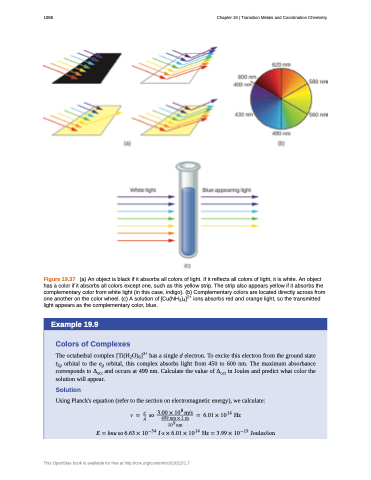Page 1098 - Chemistry--atom first
P. 1098
1088 Chapter 19 | Transition Metals and Coordination Chemistry
Figure 19.37 (a) An object is black if it absorbs all colors of light. If it reflects all colors of light, it is white. An object has a color if it absorbs all colors except one, such as this yellow strip. The strip also appears yellow if it absorbs the complementary color from white light (in this case, indigo). (b) Complementary colors are located directly across from one another on the color wheel. (c) A solution of [Cu(NH3)4]2+ ions absorbs red and orange light, so the transmitted light appears as the complementary color, blue.
Example 19.9
Colors of Complexes
The octahedral complex [Ti(H2O)6]3+ has a single d electron. To excite this electron from the ground state t2g orbital to the eg orbital, this complex absorbs light from 450 to 600 nm. The maximum absorbance corresponds to Δoct and occurs at 499 nm. Calculate the value of Δoct in Joules and predict what color the solution will appear.
Solution
Using Planck's equation (refer to the section on electromagnetic energy), we calculate:
� � �� �� ����������� � ��������� �� ��� �� � � �
��� ����� �� ��� � � ��� �� ���� � �� ��� � ���� � �� �� � ���� � ��
����������
This OpenStax book is available for free at http://cnx.org/content/col12012/1.7


